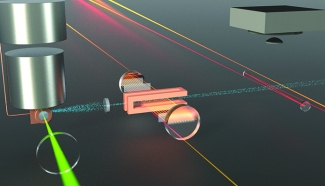The Ye group has opened a new gateway into the relatively unexplored terrain of ultracold chemistry. Research associate Matt Hummon, graduate students Mark Yeo and Alejandra Collopy, newly minted Ph.D. Ben Stuhl, Fellow Jun Ye, and a visiting colleague Yong Xia (East China Normal University) have built a magneto-optical trap (MOT) for yttrium oxide (YO) molecules (Figure 1). The two-dimensional MOT uses three lasers and carefully adjusted magnetic fields to partially confine, concentrate, and cool the YO molecules to transverse temperatures of ~2 mK. It is the first device of its kind to successfully laser cool and confine ordinary molecules found in nature.
Trapper Marmot and the Stone Cold Molecules
Magneto-optical traps for atoms were invented during the 1980s. The atom traps made it relatively straightforward for scientists to make ultracold, trapped atoms. In the process, the new traps led to revolutions in the fields of atomic and quantum physics. At JILA, they were used in the creation of the world’s first Bose-Einstein condensate, the world’s first ultracold Fermi gas, novel quantum sensors, and in dozens of other experiments with ultracold atoms.
Not surprisingly, researchers have been working for nearly 20 years to replicate the success of magneto-optical trapping with molecules. However, molecules are a lot more internally intricate than atoms, which typically have two energy levels that can be exploited simultaneously for cooling and trapping them. In contrast, laser cooling and trapping molecules (at ultracold temperatures) requires an apparatus that can address multiple energy levels at the same time.
To meet this challenge, Hummon and his colleagues added two additional lasers to their MOT, alternated the polarization of the laser light interacting with the molecules, and rapidly reversed the direction of the magnetic field around the molecules. This combination allowed them to “talk to” multiple energy levels of the YO molecules at the same time and create a more concentrated gas of much colder molecules.
However, because the new device is a two-dimensional MOT, the cooler, denser molecules are still traveling with enough speed to escape from the trap. They are also moving too fast for ultracold chemistry experiments.
To make it possible to do chemistry experiments with ultracold YO molecules, the researchers are now working on stopping their stone cold molecules in their tracks. To accomplish this, they are redesigning their MOT to trap YO molecules in three dimensions (Figure 2). The three-dimensional MOT, whimsically named the Magnetically Alternating Remixed MOT, or MARMOT, is expected to produce colder and denser trapped YO molecules that move very very slowly. Stay tuned. — Julie Phillips




 The Physics Frontiers Centers (PFC) program supports university-based centers and institutes where the collective efforts of a larger group of individuals can enable transformational advances in the most promising research areas. The program is designed to foster major breakthroughs at the intellectual frontiers of physics by providing needed resources such as combinations of talents, skills, disciplines, and/or specialized infrastructure, not usually available to individual investigators or small groups, in an environment in which the collective efforts of the larger group can be shown to be seminal to promoting significant progress in the science and the education of students. PFCs also include creative, substantive activities aimed at enhancing education, broadening participation of traditionally underrepresented groups, and outreach to the scientific community and general public.
The Physics Frontiers Centers (PFC) program supports university-based centers and institutes where the collective efforts of a larger group of individuals can enable transformational advances in the most promising research areas. The program is designed to foster major breakthroughs at the intellectual frontiers of physics by providing needed resources such as combinations of talents, skills, disciplines, and/or specialized infrastructure, not usually available to individual investigators or small groups, in an environment in which the collective efforts of the larger group can be shown to be seminal to promoting significant progress in the science and the education of students. PFCs also include creative, substantive activities aimed at enhancing education, broadening participation of traditionally underrepresented groups, and outreach to the scientific community and general public.